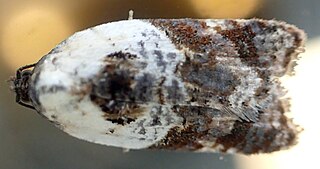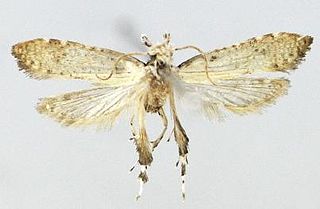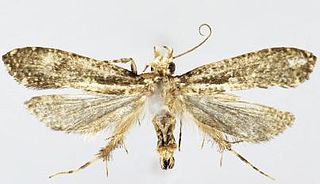
Acleris variegana, the garden rose tortricid moth or fruit tortricid, is a moth of the family Tortricidae. It has a Palearctic distribution. The moth flies from July to September mainly at night and is attracted to bright lights. The larvae feed on various trees and shrubs including rose and apple.
Psilocybe cyanofibrillosa, also known as rhododendron psilocybe and blue-haired psilocybe, is a psilocybin mushroom of the family Hymenogastraceae having psilocybin and psilocin as main active compounds. First documented in 1980 in the Pacific Northwest, it is relatively uncommon and can be distinguished from other closely related species by its smaller spores and forking cheilocystidia. Psilocybe cyanescens also has forking cheilocystidia, but less often than Psilocybe cyanofibrillosa. Psilocybe cyanofibrillosa is also distinguished from Psilocybe cyanescens by an absence of pleurocystidia. The name of this species refers to the fibrils on the Stipe (mycology) that turn bluish in age, or when handled.

Xestia ditrapezium is a moth of the family Noctuidae found in most of Europe, northern Turkey, northern Iran, Transcaucasia, Caucasus, central Asia, from the Altai to Ussuri, Amur, Kuril Islands, northern Mongolia, Tibet, China, Korea, and Japan.

Harpa doris, common name the rose harp, is a species of sea snail, a marine gastropod mollusk in the family Harpidae, the harp snails.

Cortinarius anomalus, also known as the variable webcap, is a basidiomycete fungus of the genus Cortinarius. It produces a medium-sized mushroom with a grayish-brown cap up to 5 cm (2 in) wide, gray-violet gills and a whitish stem with pale yellow belts below. The mushroom grows solitarily or in scattered groups on the ground in deciduous and coniferous forests. It is found throughout the temperate zone of the northern hemisphere.

Mycena mustea is a species of mushroom in the family Mycenaceae. First described as a new species in 2007, the fungus is known only from Kanagawa, Japan, where it grows on dead fallen twigs in lowland forests. The mushroom's dull violet to grayish-violet cap, initially covered with a fine whitish powder, becomes smooth as it matures, and eventually reaches a diameter of up to 10 mm (0.39 in). The stem is slender, up to 90 mm (3.5 in) long, and is covered with stiff white hairs at the base. Underneath the cap are distantly spaced pale brownish gills that are narrowly attached to the stem. Microscopic characteristics of the mushroom include the weakly amyloid spores, the club-shaped cheilocystidia featuring one or more short knob-like protuberances, the absence of pleurocystidia, the diverticulate cap cuticle hyphae, and the absence of clamp connections.

Isodemis quadrata is a moth of the family Tortricidae. It is known from Tibet, China.

Isodemis guangxiensis is a moth of the family Tortricidae. It is known from Guangxi, China.

Isodemis hainanensis is a moth of the family Tortricidae. It is known from Hainan, China.

Tinissa is a genus of the fungus moth family (Tineidae). Therein, it belongs to the subfamily Scardiinae.

Tinissa indica is a moth of the family Tineidae. It is found in China, Taiwan, India, Sikkim and Bhutan.

Tinissa insularia is a moth of the family Tineidae. It is found in China (Yunnan), Malaysia, Borneo, Indonesia, the Philippines, New Guinea and the Solomon Islands.

Tinissa apicimaculata is a moth of the family Tineidae. It is found in Guangxi, China.

Tinissa connata is a moth of the family Tineidae. It is found in China.

Tinissa leguminella is a moth of the family Tineidae. It is found in Yunnan, China.

Tinissa spirella is a moth of the family Tineidae. It is found in Sichuan, China.

Thisizima fasciaria is a moth of the family Tineidae. It is found in China.

Thisizima subceratella is a moth of the family Tineidae. It is found in China.
Elachista argentosa is a moth of the family Elachistidae. It is found in the United States, where it has been recorded from Ohio and Maine.













